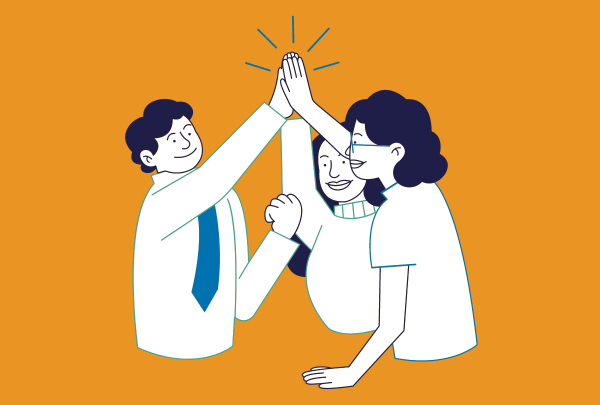Team Learning Culture: Cultivate Cross-Functional Skills
By Team Lean Agile Intelligence

Cultivate Cross-Functional Skills with Learning Culture
In today's rapidly changing work environment, a Team Learning Culture has become increasingly important for organizations to stay competitive. As Henrik Kniberg once said, "culture is the stuff people do without noticing." Creating a learning environment in the workplace and building a culture of learning within teams can help organizations stay agile, adapt to new challenges, and continuously improve. There are many benefits to this, one being that it unlocks cross-functional skills in the team which in turn enhances productivity and effectiveness.
Here, we examine the top approaches to Team Learning Culture, divulging crucial best practices that are useful at every stage of your learning expedition. By following these core techniques, you can gain the aptitude and knowledge essential to implement winning team tactics. Nevertheless, it's essential to note that Team Learning Culture constitutes just one piece of the larger picture. To obtain a comprehensive understanding of your team's ongoing process status, we recommend availing yourself of our free agile assessment for Team Agility.
Team Learning Culture and The Learning Journey
The ability to experiment, learn new skills, and share knowledge. At Lean Agile Intelligence, we refer to this process as the Team Learning Culture. Our learning journey consists of four stages - Developing, Emerging, Adapting, and Optimizing - and in this post, we will delve into each of these stages, offering practical insights and strategies to help you improve your skills in this area.

Source - Cultivate a Learning Culture With Your Organization
Developing
Teams “developing” an understanding of the value of Team Learning Culture and adopting the foundational techniques should focus on the following improvements
-
The What: The team experiments with new ways of working (i.e., process changes within their control) based on learnings from retrospectives
- The How: A good starting place to experiment with new ways of working is to review team results and brainstorm new technical or process ideas at retrospectives. Create one experiment with stated expected results to review at future retrospectives. Take the output of the retro and incorporate the experiments during the next iteration.
-
The What: The team has access to "lesson learned" documents, and they are utilized
-
The How: It's important to note that the utilization of "lessons learned" documents should be an ongoing and iterative process, and teams should continuously review and update these documents based on their evolving experiences and learnings. Here are some strategies that agile teams could use to document and access "lessons learned":
-
Create a Shared Repository: Agile teams can establish a shared repository, such as a team wiki or a knowledge base, where "lessons learned" documents are stored. These documents can include insights, best practices, and experiences from past projects or sprints. Team members can access and contribute to this repository, and it can serve as a valuable resource for reference and learning.
-
Implement Post-Project Reviews: After completing a project or sprint, Agile teams can conduct post-project reviews to capture "lessons learned." These reviews can involve the team, stakeholders, and relevant parties to reflect on the project's successes, challenges, and areas for improvement. The findings can be documented and shared with the team, and actions can be taken to incorporate these "lessons learned" into future projects.
-
Use Collaborative Tools: Agile teams can utilize collaborative tools, such as project management software, team chat platforms, or document management systems, to capture and share "lessons learned" documents. These tools can provide a central location for team members to access and contribute to these documents in real time, fostering a culture of continuous learning and improvement.
- Document and Share Success Stories: Agile teams can document and share success stories that highlight the positive impact of applying "lessons learned" in past projects or sprints. These success stories can serve as examples and inspiration for team members to apply similar practices in their current and future projects.
-
-

Emerging
Teams “emerging” beyond the foundational techniques of Team Learning Culture and are embracing it as they become more proficient, should focus on the following improvements
-
The What: The team allocates time for team members to enhance their skills within their current function (i.e., Dev, QA)
-
The How: When a team only focuses on delivery, it impacts the ability to learn new skills. There is a practice we recommend called “Slack” that comes from Extreme Programming, more details can be found here. We suggest during planning for each team member to create a task and factor it into the team capacity. That task should be dedicated to learning and improvement activities.
-
- The What: Team Members participate in Communities of Practice (CoPs)
- The How: It's important to note that participation in CoPs should be voluntary and based on the interests and availability of team members. Organizations should create a supportive and inclusive environment that encourages and recognizes team members' participation in CoPs as a means to foster continuous learning, collaboration, and professional development. Here are some examples of ways for team members to participate in Communities of Practice:
-
Regular Meetings: Agile team members can participate in regular meetings of Communities of Practice (CoPs) dedicated to their specific areas of interest or expertise. These meetings can be held virtually or in person, and can include discussions, presentations, workshops, or knowledge-sharing sessions related to Agile practices, tools, techniques, or domain-specific knowledge.
-
Online Forums or Discussion Boards: Agile team members can participate in online forums or discussion boards related to their areas of interest or expertise within the Agile community. These forums or boards can provide a platform for team members to ask questions, share insights, and engage in discussions with fellow Agile practitioners from around the world.
-
Mentoring and Coaching: Agile team members can participate in CoPs as mentors or coaches, where they share their knowledge and experiences with less experienced team members. This can involve providing guidance, answering questions, and sharing insights on Agile practices, tools, techniques, or domain-specific knowledge to help other team members improve their skills and knowledge.
-
Collaborative Projects or Experiments: Agile team members can collaborate on projects or experiments within their CoPs to explore new practices, techniques, or tools, and share their learnings with the community. These projects or experiments can provide opportunities for team members to apply Agile practices in a real-world context, learn from their experiences, and share their insights with the CoP.
-
Conference or Event Participation: Agile team members can participate in Agile conferences, events, or meetups organized by their CoPs or the broader Agile community. These events can provide opportunities for team members to learn from industry experts, engage in discussions, share their experiences, and network with fellow Agile practitioners.
-
- The How: It's important to note that participation in CoPs should be voluntary and based on the interests and availability of team members. Organizations should create a supportive and inclusive environment that encourages and recognizes team members' participation in CoPs as a means to foster continuous learning, collaboration, and professional development. Here are some examples of ways for team members to participate in Communities of Practice:
* * * * * *
"When a team only focuses on delivery, it impacts the ability to learn new skills."
* * * * * *
Adapting
Teams “adapting” the Team Learning Culture practice to extract the full benefit, should focus on the following improvements
-
The What: The team has documented their embedded skills (i.e., skills matrix) and uses it as a reference for skills development opportunities
- The How: The next step to establishing a team learning culture is for the team to grow their skills to become more cross-functional by first establishing a skills matrix. Andy Cleff has a fantastic blog post that outlines steps to do this in-depth titled “Six Steps to Self Learning Teams and Organizations” which can be found here. The steps he outlines are:
-
Build an Inventory of Skills
-
Build a Team Level Matrix
-
Create priorities, slack and flow
-
Develop Guilds
-
Measure
-
Make self-learning teams visible
-
- The How: The next step to establishing a team learning culture is for the team to grow their skills to become more cross-functional by first establishing a skills matrix. Andy Cleff has a fantastic blog post that outlines steps to do this in-depth titled “Six Steps to Self Learning Teams and Organizations” which can be found here. The steps he outlines are:
-
The What: The team allocates time for team members to learn new skills outside of their function or domain so they can assist in more ways than one
-
The How: It's important to ensure that the allocated time for learning new skills does not interfere with the team's ability to deliver on their commitments or impact the team's capacity to meet their sprint or iteration goals. Teams should also provide recognition and support for team members who take the initiative to learn new skills and contribute in more ways to the team's success. Here are some ways that teams can allocate time for members to learn new skills outside of their function or domain:
-
Dedicated "Learning Time" or "Innovation Time": Agile teams can allocate a portion of their regular work hours as dedicated "learning time" or "innovation time" for team members to explore and learn new skills outside of their immediate function or domain. This can be done on a regular basis, such as one day per week or a few hours per week, and can provide team members with dedicated time to learn and experiment with new skills or technologies.
-
Cross-Training Opportunities: Agile teams can provide cross-training opportunities where team members can learn skills from their peers or colleagues in other roles or domains within the team. For example, a developer can learn basic testing skills from a tester, or a tester can learn basic coding skills from a developer. This can help team members broaden their skill sets and be able to assist in multiple areas within the team.
-
Rotational Assignments or Job Swaps: Agile teams can offer rotational assignments or job swaps, where team members can temporarily switch roles or domains with their peers to learn new skills. This can provide team members with hands-on experience in different roles or domains, allowing them to develop a more holistic understanding of the team's work and be able to contribute in different ways.
- Internal Workshops or Lunch-and-Learn Sessions: Agile teams can organize internal workshops or lunch-and-learn sessions where team members can share their expertise or learnings related to new skills or technologies. This can provide opportunities for team members to learn from their peers and gain new skills through internal knowledge-sharing sessions.
-

Source - All-round Agile: How to Develop an Agile Learning Culture in Your Organization
Optimizing
Teams “optimizing” the knowledge sharing of the Team Learning Culture practice learnings across the enterprise should focus on the following improvements
-
The What: The team’s throughput has increased as a result of the team experimenting, learning new skills, and obtaining new knowledge
- The How: Throughput is measured by counting the numbers of items completed in a specified time period. Typically scrum teams will use velocity as a throughput metric. We recommend tracking weekly PBI completion count and focusing on achieving a consistent throughput. Overtime the practices mentioned in this blog post should show an improvement in throughput. This can be tracked for free using a team dashboard or potentially in whichever digital ALM tool you use.
- The How: Throughput is measured by counting the numbers of items completed in a specified time period. Typically scrum teams will use velocity as a throughput metric. We recommend tracking weekly PBI completion count and focusing on achieving a consistent throughput. Overtime the practices mentioned in this blog post should show an improvement in throughput. This can be tracked for free using a team dashboard or potentially in whichever digital ALM tool you use.
Throughput Chart from Focused Objective
* * * * * *
“Culture is the stuff people do without noticing” - Henrik Kniberg
* * * * * *
Conclusion
In conclusion, building a Team Learning Culture is a journey that requires commitment, patience, and continuous improvement. By focusing on the key improvements outlined in this blog post, teams can become more cross-functional, innovative, and productive. This makes creating a learning environment in the workplace vital to an organization's success. It's essential to remember that building a culture of learning takes time and effort, but the benefits are well worth it. As teams become more proficient in their team learning culture practices, they can share their knowledge and coach other teams to improve across the organization. By adopting and promoting a culture of learning, organizations can ensure they are continuously improving and staying ahead of the competition. If you want to gain a comprehensive understanding of your team’s current process status, we recommend taking advantage of our free agile assessment for Team Agility.